Our newest addition is the Panoramic x ray that takes a full image in 16 seconds. This addition of the digital Panoramic machine avoids the often uncomfortable x rays of the molar{back} teeth. The machine utilizes a fast scanning, low dose radiation acquisition. The comfort and satisfaction of our patients is paramount
Digital x rays:
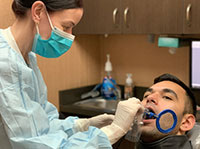 Now, state-of-the-art digital x-rays have made the technology even safer and more beneficial. Digital radiography (digital x-ray) is the latest technology used to take dental x-rays. This technique uses an electronic sensor (instead of x-ray film) that instantly captures and stores the digital image on a computer. Digital x-rays reduce radiation 80-90% compared to the already low exposure of traditional dental x-rays.
We use these x-rays to diagnose problems like periodontal disease, abscesses, decay in between the teeth, bone loss, shape and size of the roots and many more The need for dental x-rays depends on each patient’s individual dental health needs.
A full mouth series of dental x-rays is recommended every three to five years. Bite-wing x-rays (x-rays of top and bottom teeth biting together) are taken at recall (check-up) visits and are recommended once or twice a year to detect new dental problems.
Now, state-of-the-art digital x-rays have made the technology even safer and more beneficial. Digital radiography (digital x-ray) is the latest technology used to take dental x-rays. This technique uses an electronic sensor (instead of x-ray film) that instantly captures and stores the digital image on a computer. Digital x-rays reduce radiation 80-90% compared to the already low exposure of traditional dental x-rays.
We use these x-rays to diagnose problems like periodontal disease, abscesses, decay in between the teeth, bone loss, shape and size of the roots and many more The need for dental x-rays depends on each patient’s individual dental health needs.
A full mouth series of dental x-rays is recommended every three to five years. Bite-wing x-rays (x-rays of top and bottom teeth biting together) are taken at recall (check-up) visits and are recommended once or twice a year to detect new dental problems.
Intraoral camera:
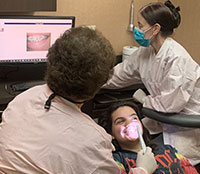 Dental intraoral cameras enable us to closely see exactly what is happening inside your mouth in high-resolution. They allow us to then project the images of your teeth to a TV screen. From there, we’re able to save the images of your teeth for your patient files. It allows us to clearly show you problem areas. We can show you a magnified version of any abnormalities and decay we find, allowing you to be more involved in the treatment process. The intraoral camera can show you before and after pictures, pin point areas of concern and allows us to educate you about your oral health. As they say: "A picture is worth 1000 words"
Dental intraoral cameras enable us to closely see exactly what is happening inside your mouth in high-resolution. They allow us to then project the images of your teeth to a TV screen. From there, we’re able to save the images of your teeth for your patient files. It allows us to clearly show you problem areas. We can show you a magnified version of any abnormalities and decay we find, allowing you to be more involved in the treatment process. The intraoral camera can show you before and after pictures, pin point areas of concern and allows us to educate you about your oral health. As they say: "A picture is worth 1000 words"
Painless Dentistry:
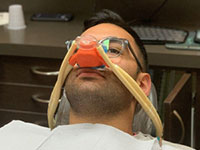 Nitrous oxide is a safe and effective sedative agent that is mixed with oxygen and inhaled through a small mask that fits over your nose to help you relax.
Nitrous oxide is a safe and effective sedative agent that is mixed with oxygen and inhaled through a small mask that fits over your nose to help you relax.
Nitrous oxide, sometimes called "laughing gas", helps make you more comfortable during certain procedures. It is not intended to put you to sleep. You will be able to hear and respond to any requests or directions. We will ask you to breathe normally through your nose, and within a few short minutes you should start to feel the effects of the nitrous oxide. You may feel light-headed or a tingling in your arms and legs. Some people say their arms and legs feel heavy. Ultimately, you should feel calm and comfortable. The effects of nitrous oxide wear off soon after the mask is removed. Due to regulatory fees and charges, there is an extra charge for the use of nitrous oxide

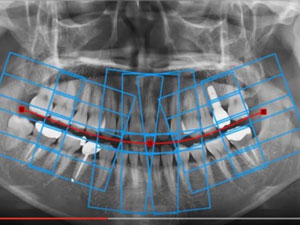
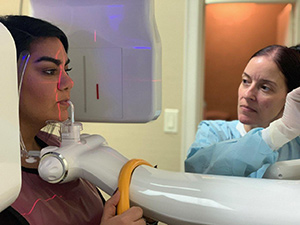
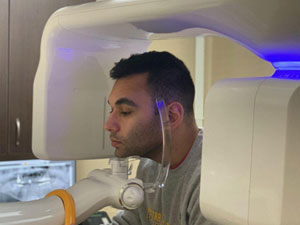
 Now, state-of-the-art digital x-rays have made the technology even safer and more beneficial. Digital radiography (digital x-ray) is the latest technology used to take dental x-rays. This technique uses an electronic sensor (instead of x-ray film) that instantly captures and stores the digital image on a computer. Digital x-rays reduce radiation 80-90% compared to the already low exposure of traditional dental x-rays.
We use these x-rays to diagnose problems like periodontal disease, abscesses, decay in between the teeth, bone loss, shape and size of the roots and many more The need for dental x-rays depends on each patient’s individual dental health needs.
A full mouth series of dental x-rays is recommended every three to five years. Bite-wing x-rays (x-rays of top and bottom teeth biting together) are taken at recall (check-up) visits and are recommended once or twice a year to detect new dental problems.
Now, state-of-the-art digital x-rays have made the technology even safer and more beneficial. Digital radiography (digital x-ray) is the latest technology used to take dental x-rays. This technique uses an electronic sensor (instead of x-ray film) that instantly captures and stores the digital image on a computer. Digital x-rays reduce radiation 80-90% compared to the already low exposure of traditional dental x-rays.
We use these x-rays to diagnose problems like periodontal disease, abscesses, decay in between the teeth, bone loss, shape and size of the roots and many more The need for dental x-rays depends on each patient’s individual dental health needs.
A full mouth series of dental x-rays is recommended every three to five years. Bite-wing x-rays (x-rays of top and bottom teeth biting together) are taken at recall (check-up) visits and are recommended once or twice a year to detect new dental problems.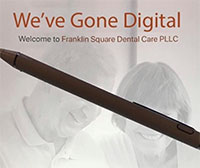 We are now paperless when it comes to health questionnaires. We will email, text or send you a QR code that will be used to answer all the questions in the comfort of your home. We will send you the questionnaires, consents, HIPPA forms, and advanced oral cancer screening forms a few days BEFORE your appointment. Once you complete it, we will have access to your answers which will be downloaded in your chart. Everything will be ready for you when you come in so we can proceed faster and without use of pen and paper. Another way of infection control. No forms will be filled in the office.
We are now paperless when it comes to health questionnaires. We will email, text or send you a QR code that will be used to answer all the questions in the comfort of your home. We will send you the questionnaires, consents, HIPPA forms, and advanced oral cancer screening forms a few days BEFORE your appointment. Once you complete it, we will have access to your answers which will be downloaded in your chart. Everything will be ready for you when you come in so we can proceed faster and without use of pen and paper. Another way of infection control. No forms will be filled in the office.  Dental intraoral cameras enable us to closely see exactly what is happening inside your mouth in high-resolution. They allow us to then project the images of your teeth to a TV screen. From there, we’re able to save the images of your teeth for your patient files. It allows us to clearly show you problem areas. We can show you a magnified version of any abnormalities and decay we find, allowing you to be more involved in the treatment process. The intraoral camera can show you before and after pictures, pin point areas of concern and allows us to educate you about your oral health. As they say: "A picture is worth 1000 words"
Dental intraoral cameras enable us to closely see exactly what is happening inside your mouth in high-resolution. They allow us to then project the images of your teeth to a TV screen. From there, we’re able to save the images of your teeth for your patient files. It allows us to clearly show you problem areas. We can show you a magnified version of any abnormalities and decay we find, allowing you to be more involved in the treatment process. The intraoral camera can show you before and after pictures, pin point areas of concern and allows us to educate you about your oral health. As they say: "A picture is worth 1000 words" Nitrous oxide is a safe and effective sedative agent that is mixed with oxygen and inhaled through a small mask that fits over your nose to help you relax.
Nitrous oxide is a safe and effective sedative agent that is mixed with oxygen and inhaled through a small mask that fits over your nose to help you relax.